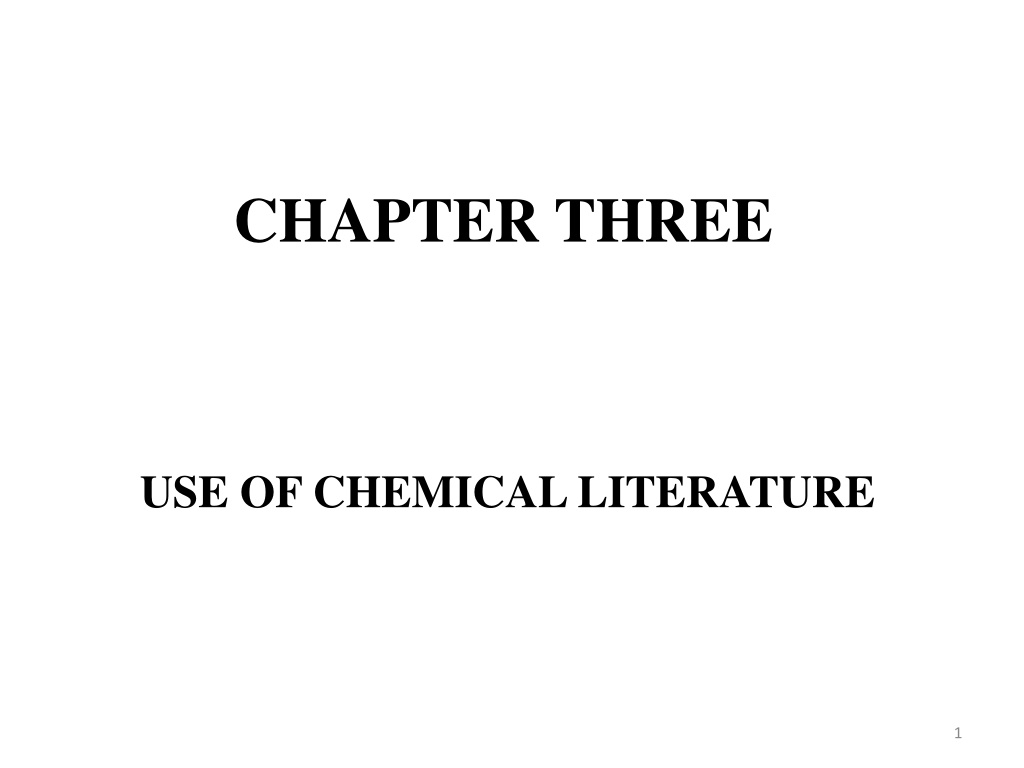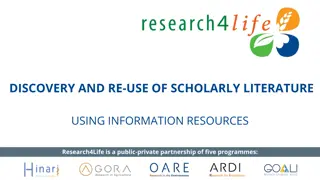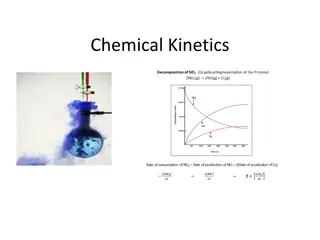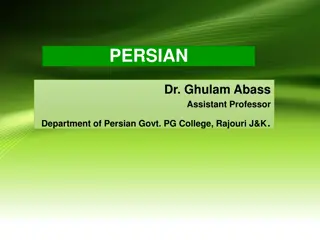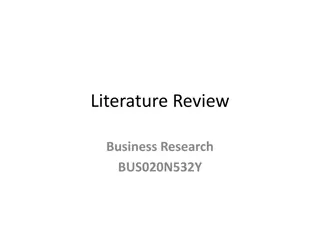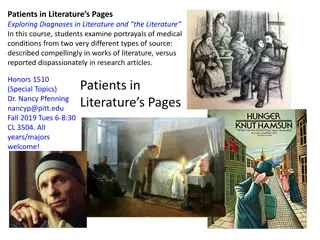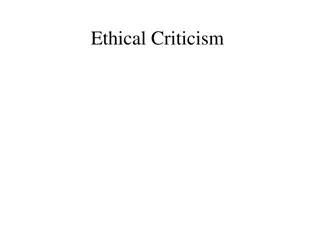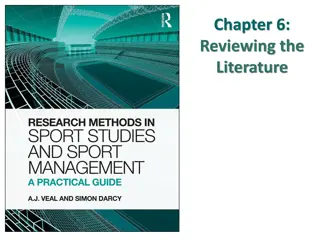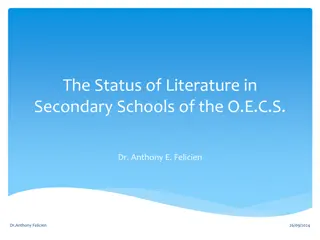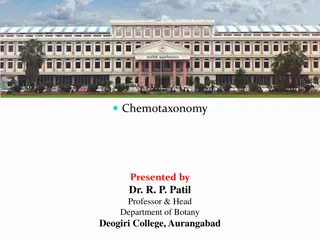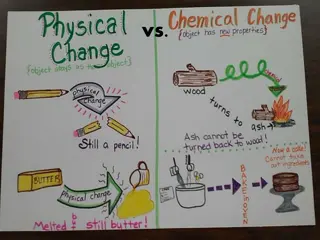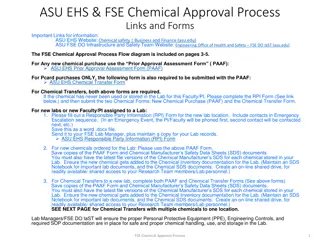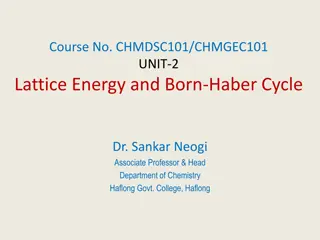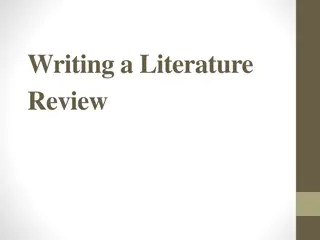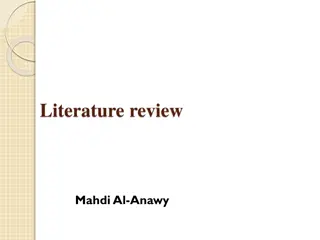Understanding the Importance of Chemical Literature in Research
Reviewing chemical literature is essential in the research process to identify existing knowledge, develop hypotheses, plan methodologies, and discover unanswered questions. The vast and complex nature of chemical literature poses challenges in finding relevant information, especially with evolving tools and terminology. Sources include primary publications like journals and patents, and secondary publications providing access to primary literature.
Download Presentation

Please find below an Image/Link to download the presentation.
The content on the website is provided AS IS for your information and personal use only. It may not be sold, licensed, or shared on other websites without obtaining consent from the author. Download presentation by click this link. If you encounter any issues during the download, it is possible that the publisher has removed the file from their server.
E N D
Presentation Transcript
CHAPTER THREE USE OF CHEMICAL LITERATURE 1
CHEMICAL LITERATURE Review of literature is one the most important steps in the research process. The main purpose of literature review is to convey to the reader about the work already done and the knowledge and ideas that have been already established on a particular topic of research. Importance of literature review Identification of research problem and development or refinement of research questions. Orientation to what is known and not known about an area of inquiry to ascertain what research can best contribute to knowledge Discovery of unanswered questions about subjects, concepts or problems Determination of a need to replicate a prior study in different study settings or samples/sizes or different study populations Description of the strengths and weakness of design/methods inquiry and instruments used in earlier research works 2
Development of hypothesis to be tested in a research study and development of research instruments Helps in planning the methodology of the present research study Identification of suitable design and data collection methods All discoveries made in the laboratory must be published The chemical literature is both vast and complex. The ability to use the scientific literature is a necessary requirement of the practicing chemist. Chemical literatures are the dominant tools for both current awareness and in-depth literature searching. In the chemical literature, you will frequently find relevant chemical names, biosequences, chemical identification numbers, structure diagrams and reaction diagrams. Why spend time talking about the chemical literature? 1. Because the subject is HUGE Chemistry strictly defined is large, and it overlaps into physics, biology, medicine, pharmaceutics, geology, materials engineering, forensics, etc. In many areas of chemistry, notably synthesis, the older literature is as relevant as the newest literature. In many areas of chemistry, the patent literature is as important as the more familiar journal literature. 3
2. Because the subject is COMPLEX Chemists are interested in information which cannot be readily defined merely by key words, such as ranges of numeric data, sets of substances with particular structural features. The terminology of chemistry, especially chemical nomenclature, is incredibly complex The patent segment of the literature is often written in terminology obscure even to trained chemists. 3. Because the tools available for chemists are RAPIDLY EVOLVING A few years ago, there was very little interest on use Internet to chemists. Now, traditional journals and databases have been reinvented for the World Wide Web, and new resources have sprung up. Chemical researcher can benefit from learning how to search chemical information and how it is organized. 4
Sources of literature Literature can be reviewed from two sources Primary: The original publication of data: journals, patents, technical reports, conferences, dissertations, preprints, some books. Secondary: Publications which provide access to the primary literature: reviews, indexes, abstracts, data collections, book series, textbooks, etc. Steps of literature reviews 1. Bibliography 2. Thematic organization 3. More reading write individual sections 4. Integrate sections 5
Stage I Annotated Bibliography Researchers read articles, books and other types of literature related to the topic of research and write a critical synopsis of each review Researchers have an annotation of each source of related literature Later, annotations are likely to include more references of other work since previous readings will be available to compare, but at this point the important goal is to get accurate Stage II Thematic organization Researchers try to find common themes of research topic and organize the literature under these themes, subthemes, or categories in a chronological manner Researchers try to coherence between themes and literature discussed under these themes 6
Stage III more reading Researchers try to discover specific literature materials relevant to the field of study or research methodologies which are more relevant for their research The researcher may be able to set aside some less relevant areas or articles which they pursued initially Stage IV integrate sections Researchers have a list of the thematic sections and they tie them together with an introduction conclusion and some additions and revisions in the sections to show how they relate to each other and to the overall theme 7
Elements of literature: introduction, body and conclusion The following steps should be taken care of: 1. Writing the introduction: Define/identify the general topic, issue, or area of concern thus providing appropriate context for reviewing the literature Point out overall trends in what has been published about the topic or conflicts in the theory, methodology, evidence and conclusions or gaps in research Establish the writers point of view for reviewing the literature, explain the criteria to be used in analyzing and comparing literature and organization 2. Writing the body Groupresearch studies and other types of literature (reviews, theoretical articles, case studies) according to common denominators such as qualitative versus quantitative approaches, conclusions of authors, specific purposes, chronology and so on 8
Summarize individual studies with as much as little detail as each merits according to its comparative importance in the literature, remembering that space denotes significance Assist the reader with strong umbrella sentences at the beginning of paragraphs and brief so what summary sentences at intermediate points 3. Writing the conclusion Summarize major contributions of significant studies and articles to the body of knowledge under review, maintaining the focus established in the introduction Evaluate the current state of the art for the body of knowledge reviewed, pointing out major methodological, flows or gaps in research inconsistencies in theory and finding areas or issues pertinent to future study Conclude by providing some insight into the relationship between central topic of the literature 9
Points to be considered for literature review Be specific and be succinct: Briefly state specific findings, methodologies used, or important points Be selective: the most important points must be mentioned in each work of review Focus of current topics: is that a more recent work, if not current, then if it is important for historical background Ensure evidence for claims: what evidence and what type of (experimental, statistical etc) evidences are offered? Is the evidence relevant and sufficient? What arguments are given? What assumptions are made and are they warranted? Focus on sources of evidence: ensure the reliability of sources of evidence 11
Account of contrary evidence: Does the author take into account contrary or conflicting evidence and arguments Reference citations: any references cited in the literature review must be included in the bibliography Avoid abbreviations technical terms or jargons Simple and accurate sentence structure and avoid errors of grammar and punctuation Referring original sources: if the reference author refers to another source whose ideas are relevant it is better to track and use that original reference Approaches to organizing the scientific literature Classification and Data Collection:- Physically grouping related data by some common element. Indexing:- Creating pointersto the original literature based on some piece of information in the original. e.g. author names or subject terms. 12
Data Collections Data Collections are a form of secondary literature in which an editor selects information from primary sources and arranges it to facilitate a particular type of access The data are reviewed and evaluated by the editors before inclusion The right data collection can be more useful than searching primary sources Types of data collections Dictionaries Encyclopedias Physical data collections (including spectra collections) Reaction and synthesis guides Analytical methods guides Comprehensive works Secondary Sources 13
BOOK Books are detailed materials with many pages (100pages or more) on a particular subject. They can be a collection of papers written by one author or several authors. PhD theses can be published as an academic book. Yearbooks Is an annual publication that provides recent information on a subject. It may serve as a regular update to a larger work or it may be an annual update of research in a certain field. The Review of Research in Education is a specialized yearbook that provides educators with current research articles on a variety of topics. Handbooks Provides brief information on a variety of topics within a subject. Provides researchers with definitions of literary terms, defining characteristics of various genres of writing, defining characteristics of historical movements in literature, and examples of the terms and concepts covered. Its primary value is the ability to provide brief information on specific aspects of a given subject 14
Monographs Preface is an introduction to a Monograph, and is a section that includes explanatory remarks that is why the monograph was written and who are the target. The preface often closes with acknowledgements of those who assisted in the literary work. Research Monographs are separately published reports on original researchthat are too long, too specialized, or otherwise unsuitable for publication in one of the standard journals. A research monograph presents results of original research. A monograph is a specialist work of writing on a single subject or an aspect of a subject, usually by a single author. The term is taken from the Latin monographia, meaning 'writing on a single subject'. 15
How to start writing a Monograph? identify, research and collect idea Preliminary step before writing: Go through a complete process of your Journal subject. Read published work in the same field. Googgling on the topic of your research work. Attend conferences/workshops/symposiums on the same fields. Understand the scientific terms and jargon related to your research work. 16
ENCYCLOPEDIAS Encyclopedias are collections of short, factual entries (articles) often written by different contributors who are knowledgeable about the topic. There are two types of encyclopedias: general and subject. General encyclopedias provide concise overviews on a wide variety of topics. Subject encyclopedias contain in-depth entries focusing on one field of study. 17
Encyclopedias are divided into articles or entries that are often arranged alphabetically by article name and sometimes by thematic categories. Encyclopedia entries are longer and more detailed than those in most dictionaries. Generally speaking, unlike dictionary entries, which focus on linguistic information about words, such as their etymology, meaning, pronunciation, use, and grammatical forms, encyclopedia articles focus on factual information concerning the subject named in the article's title. 18
Encyclopedias published in electronic format are much easier to use than printed versions, as they are much easier to search. For this reason, large general encyclopedias will no longer appear in print. Use an Encyclopedia To get a general introduction to a topic To find definitions of concepts To check important historical events and dates To check biographical data of important persons Examples Encyclopaedia Britannica (general encyclopedia) Regulatory Fish Encyclopedia (subject encyclopedia) 19
WIKIPEDIA Wikipedia is a multilingual, Web-based, free-content encyclopedia project. Wikipedia's articles provide links to guide the user to related pages with additional information. Wikipedia is written collaboratively by volunteers from all around the world. Anyone with internet access can make changes to Wikipedia articles. Since its creation in 2001, Wikipedia has grown rapidly into one of the largest reference web sites. Wikipedia's intent is to have articles that cover existing knowledge, not create new knowledge. This means that people of all ages and cultural and social backgrounds can write Wikipedia articles. Most of the articles can be edited by anyone with access to the Internet. 20
Wikipedia can be a great tool for learning and researching information. However, as with all sources, not everything in Wikipedia is accurate, comprehensive, or unbiased. You should not use only Wikipedia for primary research. Many of the general rules of thumb for conducting research apply to Wikipedia, including: Always be wary of any one single source (in any medium - web, print, television or radio), or of multiple works that derive from a single source. Where articles have references to external sources (whether online or not) read the references and check whether they really do support what the article says. Wikipedia itself offers an excellent page on using Wikipedia for research 21
Glossary A list of terms in a special subject or field with proper definitions. Incorporated at the back of a monograph, explaining or defining difficult/unusual words. A - Acidophile: organisms are those that thrive under highly acidic conditions (usually at pH 2.0 or below). B - Bacteria: small organism cannot be seen by naked eye. H - Halogenated compound: chemicals with halogen group attached to one of the carbon chain 22
